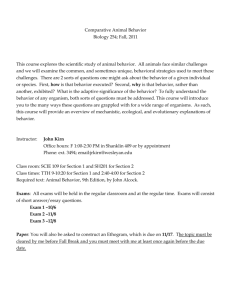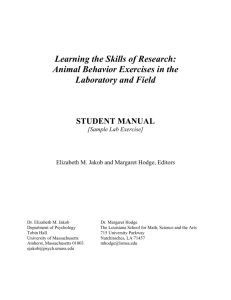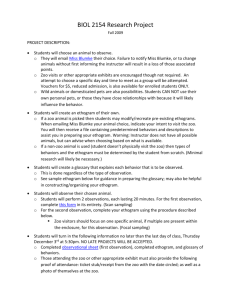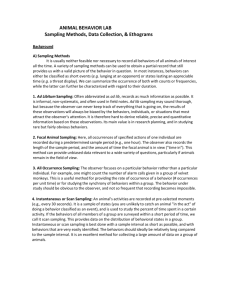Measuring Behavior: Ethograms, Kinematic Diagrams, and Time
advertisement
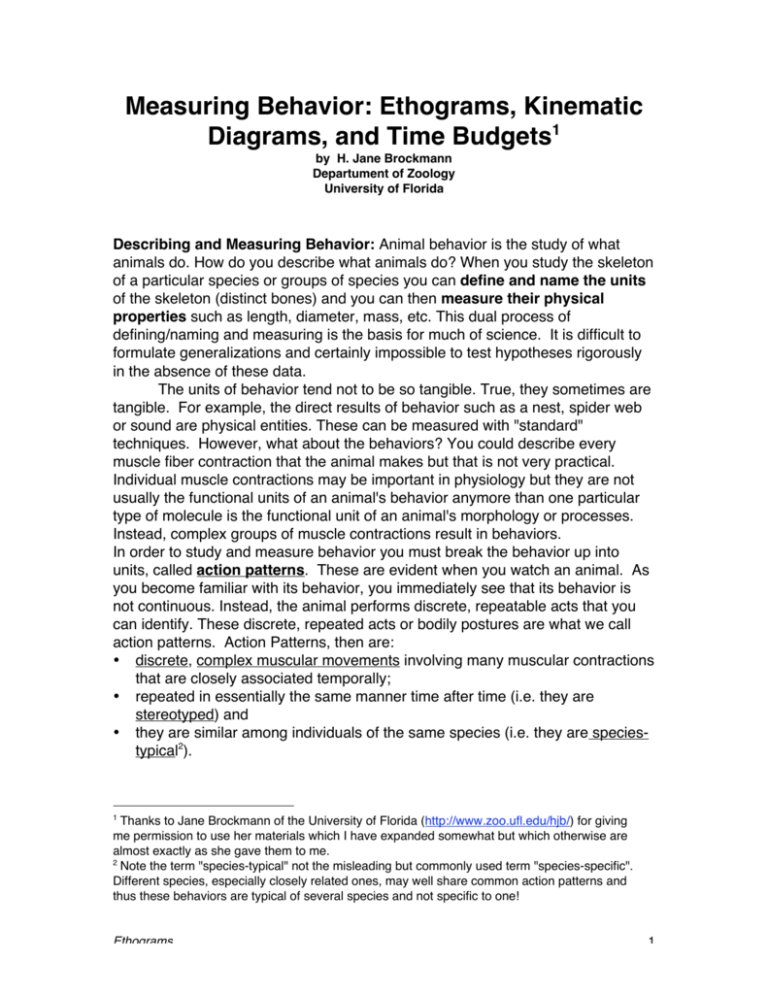
Measuring Behavior: Ethograms, Kinematic Diagrams, and Time Budgets1 by H. Jane Brockmann Departument of Zoology University of Florida Describing and Measuring Behavior: Animal behavior is the study of what animals do. How do you describe what animals do? When you study the skeleton of a particular species or groups of species you can define and name the units of the skeleton (distinct bones) and you can then measure their physical properties such as length, diameter, mass, etc. This dual process of defining/naming and measuring is the basis for much of science. It is difficult to formulate generalizations and certainly impossible to test hypotheses rigorously in the absence of these data. The units of behavior tend not to be so tangible. True, they sometimes are tangible. For example, the direct results of behavior such as a nest, spider web or sound are physical entities. These can be measured with "standard" techniques. However, what about the behaviors? You could describe every muscle fiber contraction that the animal makes but that is not very practical. Individual muscle contractions may be important in physiology but they are not usually the functional units of an animal's behavior anymore than one particular type of molecule is the functional unit of an animal's morphology or processes. Instead, complex groups of muscle contractions result in behaviors. In order to study and measure behavior you must break the behavior up into units, called action patterns. These are evident when you watch an animal. As you become familiar with its behavior, you immediately see that its behavior is not continuous. Instead, the animal performs discrete, repeatable acts that you can identify. These discrete, repeated acts or bodily postures are what we call action patterns. Action Patterns, then are: • discrete, complex muscular movements involving many muscular contractions that are closely associated temporally; • repeated in essentially the same manner time after time (i.e. they are stereotyped) and • they are similar among individuals of the same species (i.e. they are speciestypical2). 1 Thanks to Jane Brockmann of the University of Florida (http://www.zoo.ufl.edu/hjb/) for giving me permission to use her materials which I have expanded somewhat but which otherwise are almost exactly as she gave them to me. 2 Note the term "species-typical" not the misleading but commonly used term "species-specific". Different species, especially closely related ones, may well share common action patterns and thus these behaviors are typical of several species and not specific to one! Ethograms 1 Action patterns are often defined in terms of the following characteristics: • the form of the action. • the velocity of the action -- how rapid are the movements of the action pattern? • the duration or how long the movements are held in different positions. • the amplitude or the height of the action. • the orientation of the behavior towards objects in the environment, including conspecifics. Typically, an ethologist spends some time observing a species and comes to identify what he believes are important behaviors. These action patterns are described in words, typically along with drawings or photographs and then the pattern is given a descriptive name. Look at the action patterns for mallard ducks depicted below. One is a posture (head-round) while the others all involve motions from simple head shaking to more complex motions that involve much of the body: Ethograms 2 Ethograms: The most basic data in ethological studies is an ethogram. Classically, ethograms are thought of as a complete encyclopaedia of an animal's action patterns. As was just mentioned, the patterns are descibed in enough detail so that another observer can readily pick them out. Ideally: • No attempt to explain either the proximate or ultimate cause of the behavior is included in the description. • Moreover, the name given to the action pattern should be selected to be descriptive and not to infer function. The aim is to be neutral with respect to purpose and at the same time as descriptive as possible. The purposes and causes of the behavior are to be considered later and ideally come as the result of testing hypotheses as to the function of particular action patterns. Names that suggest function are to be avoided for the very reason that the suggestion may be misleading and tend to bias the ethologist. Again, photographs or more ideally drawings are invaluable. Ethograms 3 Generalized and Special Purpose Ethograms: In the past, it was very common to try to obtain a complete inventory (the encyclopedia mentioned above) of an animal's behaviors. This is still desirable, but more often, specialized ethograms are obtained that are valid for individuals in a certain context. For example, an ethogram could be made of behaviors exhibited when individuals compete for a particular resource. The purpose of doing this would be to have a catalog of behaviors that are relevant to a particular type of broad question (proximate or ultimate) that is being asked about the animal. One other thing to keep in mind about ethograms is that they often apply to individuals of a certain life stage or sex. We will make such a specialized ethogram using male Betta splendans -- Siamese Fighting Fish. Ethograms and Sequences of Behavior. Behaviors often do not occur in isolation and so we quickly want to move beyond a catalog of behavior. Thus, once you have the have the action patterns clearly defined and the ethogram written down then you can begin to record sequence data. The ultimate goal will be to produce a diagram that summarizes the likelihood of various behavioral sequences. This type of diagram is called a kinematic diagram. To understand its usefulness, we'll go through the steps of creating one and then see what it will tell us. Let's assume that we are observing mallard ducks and we are interested in situations where the following behaviors are common (some of these were shown above): bd tw bill dip tail wag hs wf head shake wing flap pw preen wing bs bill shake Note that a short, easy-to-remember abbreviations is given for each action pattern. This makes recording data easier. Now, suppose that you are watching a duck. You simply record the action patterns in the order in which they occur, i.e. the sequence of events. The following is an example of a possible sequence using duck action patterns: bd hs pw bd hs pw bd hs hs bd pw bd hs pw hs hs hs pw bd hs pw bd hs wf tw bd hs pw bd hs hs pw bd hs hs pw hs wf tw bd Note that three head-shakes in a row are recorded as "hs hs hs," not just as "hs." We can use the observed sequence of action patterns to construct a matrix that lists the number of times that each behavior follows another. Thus, it gives the number of times that there is a transition from one type of behavior to another. This primary transition matrix has in its left-most column the codes for all the action patterns that were observed (the blue lettered codes in the Ethograms 4 example below). These same abbreviations are also used as headings for each for column in the top row (in red below). Each cell will contain the number of times the behavior indicated at the left (in blue) was followed by the behavior heading the column (in red). To obtain these counts, you start with the first two observed action patterns (bd followed by hs above) and score it. You then shift along by one behavior (so the next sequence is hs followed by pw then pw followed by bd, etc). The result is a matrix that shows the number of times each behavior listed in the column on the left is followed by each other behavior. Thus, it gives the number of times there was a transition from one type of behavior to another. As was noted in the box above, a behavior can repeat itself -- follow itself. The total number of times a sequence is starts with a particular action pattern is given in the right-most column (purple). Here is the matrix that shows the number of each type of transition for the sequence given above: Behavior bd hs pw wf tw total Followed by: bd hs 0 9 1 5 7 2 0 0 2 0 pw 1 8 0 0 0 wf 0 2 0 0 0 tw 0 0 0 2 0 total 10 16 9 2 2 39 Note that in the sequence bill shake "bs" did not occur and so it is not in the matrix. We next calculate the transition frequency for each behavioral sequence. This is simply the percentage of times that a particular action pattern follows another (given the first action pattern). For example, since 9 out of 10 bd were followed by hs, the transition probability is 9/10 = 0.9. Here is a transition frequency matrix based on the data on the previous table. bd bd 0 hs 1 /16=0.0625 pw 7/9=0.7778 wf 0 tw 2/2=1.0 hs 9/10=0.9 5/16=0.3125 2/9=0.2857 0 0 pw 1/10=0.1 8/16=0.5 0 0 0 wf 0 2/16=0.125 0 0 0 tw 0 0 0 2/2=1.0 0 total 1.0 1.0 1.0 1.0 1.0 Please note that transition frequencies as read across a row must sum to approximately 1.0 since that is all the action patterns that followed a particular Ethograms 5 behavior. On the other hand, there is no reason that individual columns need to add to 1.0 since each only contains the proportion of times and action pattern was preceded by a particular AP. The matrix in shown above was constructed from a single sequence of action patterns, such as would be produced by one continuous observational session on an individual animal. Usually, however, a matrix is constructed from a set of sequences from individual animals. Sometimes, separate sequences may also be recorded for the same individual if continuous observations of that individual are periodically interrupted (e.g. if the animal flies away and returns later). Kinematic Diagram: A kinematic diagram simply shows the flow of the behavior. Making one is like constructing a puzzle. First, place the abbreviations for the action patterns in boxes. You may want to add sample sizes (from the primary transition matrix, right column) into the box with each behavior. Next , start with any behavior and draw arrows to the boxes containing the other behaviors that occur after it. Here is an example where I started with bill dip which was followed 10% of the time by preen wing and 90% of the time by head shake: Notice from the transition frequency matrix that bd follows tw but not the reverse order. The direction of the arrows indicates which behavior leads and which follows. We then add other data from the matrix. First, we add transitions from head shake. Notice that 6.25% of head shakes preceded bill dips etc. Also notice that head shakes sometimes followed other head shakes. That is what the arrow that starts and finishes on head shake indicates: Ethograms 6 pw bd 0.9 0.3125 hs 0.1 0.0625 0.5 0.125 wf Notice that I have removed the total number of observations from this and the remainder of the diagrams so as to keep things simple. Next we add the transitions for preen wing (in blue): and finally we add the missing behavior, tail wag and its transitions: Ethograms 7 Now, this is hard to read with all its crossing lines, so let's re-organize it a bit while preserving all the data. There are a number of ways to do it, but here is one version of a result: 1.0 tw wf 1.0 0.125 0.0625 bd hs 0.9 0.1 0.3125 0.2857 0.5 0.7778 pw How do we read this table -- what is the use of a kinematic diagram? Notice that at a glance you can see which action patterns follow which others. Moreover, you can also see the frequency with which various patterns follow follow each other. Ethograms 8 Time Budgets3: An ethogram gave us a list of the characteristic action patterns of an animal and the kinematic diagram gives an excellent overview of behavioral sequences and how frequently certain behaviors occur. However, neitther really tells us how much time an animal spends performing each behavior. Note that even though a behavior is very common, it may be that the animal still spends very little time at it because it is brief. Time is an important commodity to all organisms, given that life is finite and that opportunities are often fleeting. We will see later in the course that in many activities animals carefully regulate their "expenditure" of time. Moreover, in some cases, time can also be a good stand-in for energy -- especially if the activitiy is steadily performed. A time budget for an animal is just like one for a human -- it lists the percentage of time that an animal spends doing various activiites. These "activities" may be either particular action patterns such as producing a territory call or they could be more broadly defined activities such as territory maintenance. The latter would include calling, patrolling and perhaps even fighting. Time budgets are obtained by: • defining the behavioral units under consideration (somewhat and perhaps totally akin to obtaining an enthogram) • measuring the time spent on each of these • totalling the time • obtaining a fraction for each activity. Time budgets are very important in behavioral (and physiolgical) ecology. For instance, in my (Ken Prestwich) research, I have often found it useful to determine how much time male crickets spend searching for mates, resting, building burrows, feeding, and calling. Note that most of these activities are more complex than typical action patterns -- perhaps only calling (a very stereotyped behavior involving raising the forewings 45o and then stridulating them against each other many times each second) and resting would be considered an action pattern. The others are complex patterns involving many specific action patterns. I used the time budgets I measured to work out a respiratory energy budget . These tell how much energy a cricket expended in various activities. In one species, Anurogryllus arboreus (see the cricket on my webpage), males use about 25% of their daily total energy expenditure calling to females. They do this in about 25 minutes (i.e., less than 2% of the day). Who said sex wasn't important! 3 This section is by Ken Prestwich of Holy Cross College Ethograms 9
